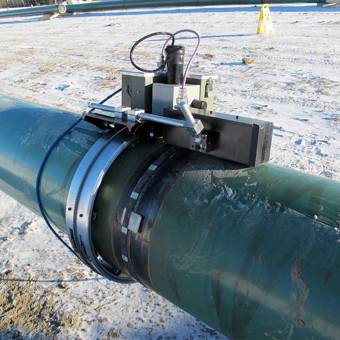Simplify Your Project: Dependable Pipeline Welding Inspection Specialists at Your Service
Wiki Article
Comprehensive Summary of Pipe Welding Inspection Treatments
Pipeline welding examination treatments play an essential role in assuring that welded connections fulfill strict sector requirements and specifications. From meticulous pre-welding examinations to extensive post-weld evaluations, a distinct evaluation procedure is necessary for preserving the structural soundness of pipelines.Pre-welding Inspection Preparations
Before commencing the welding procedure, detailed pre-welding examination prep work are vital to make sure the stability and high quality of the weld joint. These preparations entail a careful evaluation of the materials to be welded, the welding tools, and the work environment. By performing complete pre-welding examination prep work, potential concerns can be determined and dealt with early on, leading to top quality and trusted weld joints.Welding Procedure Qualification
Thorough pre-welding evaluation prep work lay the foundation for the vital process of Welding Treatment Credentials, ensuring the honesty and high quality of the weld joint. Welding Treatment Credentials (WPQ) is a crucial action in the welding procedure that involves screening and accrediting welding treatments to guarantee they meet specific requirements and demands. The WPQ procedure typically includes welding treatment requirements advancement, welding procedure qualification screening, and paperwork of the results.Throughout welding procedure spec advancement, vital information such as the welding procedure, welding materials, joint design, and welding criteria are defined to produce a thorough treatment. Consequently, welding treatment qualification testing is carried out to confirm the suggested procedure's integrity. This screening often involves welding test vouchers that go through numerous mechanical and non-destructive tests to evaluate the weld's quality and adherence to the defined criteria.
In-process Weld Evaluation
Throughout the welding procedure, in-process weld evaluation plays a vital role in guaranteeing the quality and integrity of the weld joint - Pipeline Welding Inspection. This sort of assessment involves monitoring the welding specifications, evaluating the weld grain formation, and discovering any type of prospective flaws or stoppages as they occur. By conducting in-process weld inspections, welding drivers can promptly resolve any issues that might emerge, thereby preventing more problems and guaranteeing that the last weld satisfies the required specsUsual methods used for in-process weld inspection consist of aesthetic inspection, fluid penetrant testing, magnetic bit screening, ultrasonic testing, and radiographic screening. Overall, in-process weld evaluation is crucial for maintaining the high quality and reliability of welded pipelines.
Non-destructive Screening (NDT)
Non-destructive Screening (NDT) is a vital technique utilized in pipe welding evaluation to analyze the integrity of weld joints without causing damage to the welded framework. By utilizing different NDT techniques, assessors can assess the top quality of welds and determine any type of issues or gaps that might endanger the architectural strength of the pipe. Usual NDT methods made use of in pipeline welding assessment consist of Radiographic Screening (RT), Ultrasonic Screening (UT), Magnetic Bit Testing (MPT), Liquid Penetrant Testing (LPT), and Visual Testing (VT)RT involves making use of X-rays or gamma rays to generate pictures of the internal framework of the weld, allowing inspectors to identify problems such as porosity, splits, or incomplete fusion. UT utilizes high-frequency acoustic waves to spot flaws underneath the surface of the weld, supplying comprehensive info regarding the dimension this article and location of defects. MPT and LPT are utilized to recognize surface-breaking defects by using magnetic bits or penetrant liquids to the weld location. Additionally, VT entails aesthetic examination of welds to recognize any kind of visible flaws.
Post-weld Examination and Documents


Documents of post-weld evaluation searchings for is important for maintaining quality control documents and guaranteeing conformity with sector standards and laws. Comprehensive reports should consist of details about the examination methods made use of, the place and nature of any kind of defects discovered, and any type of corrective actions taken - Pipeline Welding Inspection. Appropriate documents not just acts as a document of the weld's top quality yet also aids in future maintenance and evaluation processes
Verdict

In final thought, pipeline welding assessment treatments play an essential role in making certain the top quality and honesty of welds. Generally, adherence to correct assessment protocols is crucial to the success of pipe welding projects.
From thorough pre-welding evaluations to detailed post-weld evaluations, a distinct inspection procedure is essential for maintaining the structural sturdiness of pipelines. By carrying out in-process weld evaluations, welding operators can promptly attend to any kind of concerns that may emerge, thus preventing additional defects and guaranteeing that the last weld meets the required check my blog requirements.
Common techniques utilized for in-process weld inspection consist of visual assessment, fluid penetrant testing, magnetic fragment screening, ultrasonic testing, and radiographic screening.Non-destructive Screening (NDT) is an important method employed in pipe welding examination to examine the honesty of weld joints without triggering damages to the bonded structure. Post-weld examination entails different techniques to examine the welds for defects, including aesthetic examination, color penetrant screening, magnetic bit testing, ultrasonic screening, and radiographic screening.
Report this wiki page